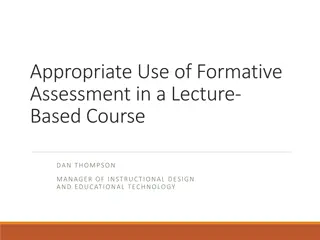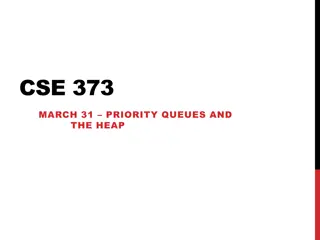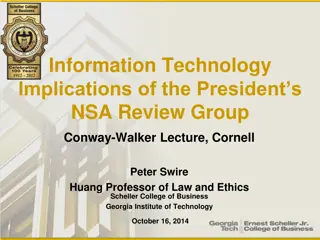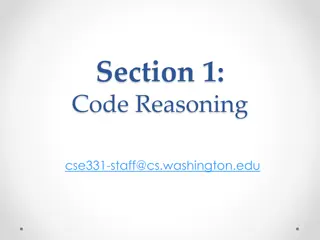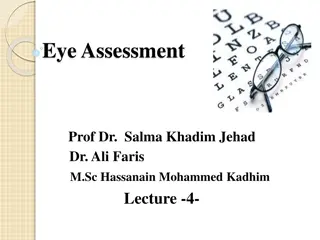
Research Design and Methods in Psychology
Explore the intricate world of research methods in psychology, from recall and philosophy of science to data analysis and research design. Delve into the principles that guide us in creating meaningful and reliable research studies, understanding the importance of random assignment, qualitative and quantitative data, hypothesis testing, and more. Discover the challenges and nuances of conducting experiments in real-world settings, emphasizing the prevalence of descriptive studies and quasi-experiments. Uncover the essential lessons learned to avoid self-deception and accurately interpret research findings.
Download Presentation

Please find below an Image/Link to download the presentation.
The content on the website is provided AS IS for your information and personal use only. It may not be sold, licensed, or shared on other websites without obtaining consent from the author. If you encounter any issues during the download, it is possible that the publisher has removed the file from their server.
You are allowed to download the files provided on this website for personal or commercial use, subject to the condition that they are used lawfully. All files are the property of their respective owners.
The content on the website is provided AS IS for your information and personal use only. It may not be sold, licensed, or shared on other websites without obtaining consent from the author.
E N D
Presentation Transcript
Psychology 3301 Lecture 3
Recall Research? Methods? ? Philosophy? Of? Science? Research? Design? Statistics? Measurement? Data? Analysis? No? random? assignment? of? S s? to? conditions? Random? assignment? of? S s? to? conditions? Qualitative? Data? Quantitative? Data? Hypothesis? Testing? Estimation? ? Positivism? ? Popper? ? Sampling? Methods? Non-probability? Probability? ? Experiment? ? All? sorts? of? stuff? about? confounding,? blinding,? placebo? effects,? matching,? blocking,? etc.? *? ? ? Reduce? ? Summarize? ? Convey? meaning? ? Loss? functions? ? ? Decision? procedures? ? Point? hypotheses? ? Distribution? theory? ? Test? statistics? ? Theory? of? errors? ? No? room? but? we? don t? teach? much? of? this? stuff? anyway.? ? Operationism? ? CV? Theory? ? Kuhn? SRS? SYS? PPS? STR? Cluster? ? Content? ? Narrative? ? Discourse? ? Framework? ? Grounded? Theory? ? ? Univariate? ? Realism? ? T? constructs? ? Description? vs? explanation? vs? law? vs? prediction? vs? model? vs? theory? ? Determinism? vs? mechanism? vs? reductionism? vs? humanism? shape? location? spread? kurtosis? ? Reliability? ? Validity? ? CTT? ? IRT? ? ? Descriptive? Study? Case? study? Survey? Naturalistic? Interview? ? Quasi-Experiment? Pre-post? Pre-post-control? Time? series? Time? series? control? ? Other? Cohort? study? Guided? interview? Retrospective? Prospective? ? ? Bivariate? linear? correlation? non-lin? correl? ? Multivariate? MDS? PCA? FA? ? Metric? vs? Non-metric? ? Model? fitting? ? *? All? designed? to? attune? students? to? the? ways? in? which? our? methods? of? design? can? cause? our? research? to? mislead? us? about? the? way? in? which? the? world? really? is.? The? major? reason? for? research? methods? in? the? first? place.? ? The? reason? we? must? pay? attention? to? these? issues? is? that? most? of? these? principles? are? nothing? but? hard? learned? lessons? about? the? way? in? which? we? deceive? ourselves? by? the? methods? we? use? to? try? to? understand? the? world.? Although? they? are? listed? under? experiments,? these? are? principles? that? apply? to? ALL? methods? of? data? collection? and? analysis.?
Research Design, Continued In 35 years as a consultant methodologist and statistician, I have never seen an experiment conducted in the real world. Experiments are done in academic research environments, not in the real world. Why? Because in the real-world, there is no random assignment of subjects to conditions. It s not practical. So, in the real-world we mostly see descriptive studies, and quasi-experiments. Consider the masses of COVID-19 data you have seen. Have you seen any experiments? What we tend to see are descriptive methods how many X are Y and quasi experiments what is the relationship between X and Y.
Research Design: No Random Assignment of subjects to Conditions In this category we have descriptive studies, surveys, naturalistic studies, interviews, quasi-experiments, cohort studies, etc. These constitute the vast majority of research studies conducted in both a real-world and academic contexts. They typically lack the controls necessary to make strong causal claims. Such claims are reserved for designs in which there exists random assignment of subjects to conditions, in which the conditions differ on the putative causal variable the IV. Consider the How well we have done in BC arguments about managing COVID deaths. Have we randomly assigned subjects to BC and Other countries/states ?
The Quasi-Experiment and Causal Claims To understand why causal claims are problematic in quasi- experimental contexts, we need to review some basic quasi- experimental methods. Let s start with the post-test only design. An intervention followed by a measurement of a DV. The most basic design but very common in industry. Imagine we conduct a sales training program in which we provide a day of sales training and ask participants at the end of the day How confident are you in your sales ability? Let s say our scale is 1-7 with 7 being very confident and 1 being not confident at all. Now let s imagine the average score is 6.2. Data derived from designs like this are very commonly used to justify that a program or initiative is effective.
Post-Test Only Design Problems So what s the problem here? There are three major problems: i) The in comparison to what problem ii) The generalizability problem iii) The measurement or meaning problem The conclusion is Sales training programs are effective , the justification is participants took a sales training program and reported a high level of confidence in their sales ability after the program. The question is Is the conclusion justified by the method? Let s start with the problem of In comparison to what ?
In Comparison to What Implied by the statement sales training programs are effective is that it s sales training programs specifically that are effective. Embedded within this phrase is a hidden causal claim. But is it justified on the basis of a post-test only design? So, imagine we ask prospective participants that took no sales training program at all the same question. Imagine a mean score of 6.3. Given this comparison to another group, a causal claim seems difficult to justify. What about comparison to a previous point in time? What if we ask the same question before the program begins and get a mean of 6.3. Now, we see a reduction in confidence after the program. Again, evidence that a causal claim is not justified.
In Comparison to What My wife recently told me that she had read a news article in which it was reported that France is going in to lockdown again. I asked Why ? She said because ICU s are at 70% capacity. I asked even before thinking What is the normal percent capacity at this time of year ? She said she did not know and that it was not reported in the news article. Even though we technically know from our research methods courses that comparisons are important, it is extraordinarily common for us not to fully recognize this in the real-world when dealing with real-world problems.
The Generalizability Problem The question here is whether or not the results of this post-test only design can generalize to other contexts, types of programs, program leaders, etc. Since only one kind of program was conducted at one point in time with one set of participants, and in one context, the method does not justify the conclusion that the results can be generalized beyond the research context. What conclusion is justified? This program, conducted by these people, in this context, at this point in time, for these participants was Let s look at the translation of this idea of generalizability to our thinking about the effect of things in our daily lives Let s APPLY APPLY this methodological principle.
The APPLIED APPLIED Generalizability Problem: COVID Example Consider the phrase COVID-19 is a serious disease . The generalizability problem is Is COVID serious in all contexts, for all people, across time, etc.? Let s consider an example What is the relationship between residing in a retirement home and the seriousness of COVID-19 ? In Canada, based on the latest data, 81% of the 10,000 COVID deaths have been in retirement homes. Let s do a quick calculation
The APPLIED APPLIED Generalizability Problem: COVID Example Given that 81% of the 10,000 deaths were in retirement homes and that approximately 128,000 Canadians live in retirement homes, the risk of death for residents of retirement homes is .81(10,000)/128,000=.063 Now, the risk of death to all 37,600,000 Canadians, excluding residents of retirement homes is roughly something like .19(10,000)/(37,600,000-128,000)=.00005 So, given these admittedly rough, highly conditional calculations, it s clear that the risk of death is a huge function of who the participants are. The seriousness of the disease then is highly conditional, and so not generalizable across segments of the population.
The APPLIED APPLIED Generalizability Problem: COVID Example Over Time When we say COVID is a serious disease , we do not make the statement conditional on time. So we generalize to all times by making the statement this way. But is the seriousness of COVID a function of time?
The Measurement/Meaning Problem To what extent does the post-test only design address the measurement or meaning problem? What is the measurement/meaning problem? Consider the statement Sales training programs are effective . The measurement/meaning problem is How do we measure effective? And that question depends upon What do we mean by effective?
The Measurement/Meaning Problem Does effective mean . Self-reported perception of competence on a scale of 1-7 Does it mean Total sales per day of all products and services Does it mean Percent of total sales force sales per day The issue of course is that there are an infinite number of ways of conceptualizing effective . The problem is that the definition we choose will effect our conclusions about efficacy.
The Measurement/Meaning Problem: COVID Example Is COVID serious? What do we mean by serious? Let s say we mean Serious if percent of positive tests above 5% . Let s look at some data. Serious between the end of March and the end of June
The Measurement/Meaning Problem: COVID Example Let s say we mean Serious if daily deaths per million in Canada greater than 1 . Serious Not serious Not serious Serious
The Measurement/Meaning Problem: COVID Example But what if we mean Serious if daily deaths per million not residing in retirement homes more then 1 per million . Not serious Not serious Serious on 2 days in last 10 months
The Measurement/Meaning Problem: COVID Example What about Percent of total excess deaths in comparison to the same day over the previous 5 years .
The Measurement/Meaning Problem: The Take-Away How we define and measure serious matters. Not just a lot it s, in Wittgenstein s words and from the perspective of an operationist, fundamental to the problem. Consider this when will it be safe to return to university in-person teaching? What does that depend upon the definition of safe to return. I encourage you to look for one. Listen to our experts have they given one? I think you will find that they have not. It follows then that it can not be known when it is safe to return because we do not know what safe to return means.
Back To Quasi-Experimental Designs We started with post-test only design and realized quickly that this kind of design suffers from a fundamental In comparison to what problem. We address this issue in two ways. i) Pre-test type design ii) Non-equivalent control designs In pre-test designs we use either a single pre-test and single post-test or multiple pre-tests and multiple post-tests. Where we use multiple pre and post-tests, we call these series designs. In non-equivalent control designs, we measure the variable of interest in more than one group. Let s look at pre-test, post-test designs
Pre-Test, Post-Test and Series Designs Let s look at some quasi-experimental design data on the efficacy of masks in reducing COVID cases. Masks mandated PRE POST
Pre-Test, Post-Test and Series Designs Let s look at France. They introduced compulsory masks on September 1. Ireland France PRE POST
Non-Equivalent Control Series Designs Let s look at Ireland as the experimental group and Sweden as the non-equivalent control. Ireland Introduces Masks, Sweden Does Not
Non-Equivalent Control Series Designs Let s zoom in for a more clear picture. Ireland Introduces Masks, Sweden Does Not
Non-Equivalent Control Series Designs Just for fun, what about daily deaths per million as a different definition of serious. Ireland Introduces Masks, Sweden Does Not
Non-Equivalent Control Series Designs Maybe it s just Ireland. What about France? France Introduces Masks, Sweden Does Not
The Best Design: Non-Equivalent Control Series Reversal Designs What happens when we introduce and then remove lockdowns? Lockdowns in Ireland gradually tightened Lockdowns in Ireland gradually lifted No lockdown in Ireland Lockdown in Ireland
In Comparison To What: The Take Away The comparison question is fundamental to our conceptualization of a problem. In the famous words of Thomas Sowell (who I encourage you very much to follow), there are no solutions, there are just trade-offs. This means two things from our point of view: i) When we modify something in the world (we impose mask wearing laws, we elect a new leader, we open safe injection sites, etc.), many things will happen. Some things will get better, some thing will get worse, some things will not change at all. ii) When we compare two groups (experimental group vs. non-equivalent control for example), some things will be better for one group, some things will be worse and some things will be the same. Consider this
In Comparison To What: The Take Away What has happened to overdose deaths in BC since response to COVID began in March of 2020? COVID Restrictions Introduced Dramatic Increase Same time last year, dramatic decrease Same time 2018, no change Same time 2017, decrease Same time 2017, no change Understanding this In comparison to what issue and putting in to practice in your own thinking about the world is an antidote to simplistic thinking and simplistic world views.
In Comparison To What: One More Very Important Issue To Keep in Mind The comparison question is fundamental to our conceptualization of a problem. But part of the question is when or at what point in time we choose to engage the comparison. This is known as the apriori vs post-hoc problem. Imagine we give the graphs of cases or deaths to a statistician or researcher but do not say when the intervention was initiated. So, for instance, we do not say when mask wearing restrictions were instigated. The question is, can we tell apriori or before we know when the intervention was implemented when it was, in fact, implemented by analysis of the case and death rates.
In Comparison To What: One More Very Important Issue To Keep in Mind So, look at the cases graph below can you tell when mask wearing was initiated in Ireland? The question is, how do the apriori guesses compare to the post hoc reality? Would you be accurate in your guess?
Apriori vs Post-Hoc Problem: Take Away We have a tendency to think that we are much better at predicting the future than we really are. Why is that? Partly because we do not fully understand the risks associated with post-hoc thinking. Or, in more common language, I told you so or I knew it all along or I said this would happen thinking. The antidote to this is to state clearly, in advance, one s expectations and then review those expectations after the fact. This is the familiar idea of stating one s research hypothesis in advance and then evaluating the data against the hypothesis. We do this technically but almost never in the real-world.
Apriori vs Post-Hoc Problem: Take Away For instance, a statement was recently made in British Columbia that a type of lockdown is required in order to reduce the number of COVID cases in ICU. Methodologically, this is called a research hypothesis. So, strictly speaking, a methodologically oriented person might state, in advance of the lockdown, how much reduction should be expected in COVID ICU cases following the lockdown. Strictly speaking, this should be stated in such a way that it is possible to FALSIFY the hypothesis. That is, it should be stated clearly enough to determine whether or not the lockdown did actually have the expected effect. Watch for this in your own predictions and in your own thinking about the world. If you do, you ll find out that you are much worse at predicting the future than you think!
Exercise Two In this exercise, I d like you to conduct a Non-equivalent control reversal series design. You should use a data file I have created with 74 rows and over 100 columns. Subjects are years and columns are a vast array of variables from number of deaths on Everest each year to ocean heights in the Boston harbour. The independent variable I would like you to use (the variables we will be introducing and reversing numerous times in the US party in power . This indicates whether a republican or democratic national government was in power in a given year in the USA. The dependent variables I would like you to use are: the annual per capita electric power consumption, C02 emissions in tons per capita and income in US dollars per capita. The non-equivalent control is Canada.
Exercise Two STEP 1: Graph Co2 emissions per capita in the US by year. STEP 2: Place lines on the graph indicating years of democratic and republican government. STEP 3: Name the design and draw conclusions about the effect of government on Co2 emissions. STEP 4: Add a non-equivalent control to the graph, Canada, and revise your conclusions if necessary. STEP 5 Discuss why you revised or did not revise your conclusions and why it is so important (or not) to cite data that allows an analysis of the in comparison to what problem. STEP 6: Repeat this procedure for the other two DV s and discuss. Finally: Say what you think the effect of the government is on these economic and environmental variables. Use the variable fertility rate in the US to provide insight. Watch a video here on how to go about this analysis in SPSS.
What to Do With Your Findings Go to Blackboard and find the Discussion folder in the main menu. Go to this folder and make a post on the discussion forum Exercise Number Two . Answer each of the questions and take a look at what other students are saying about this. Engage other students on the final question of whether or not the party in power has an effect on the variables in question.





